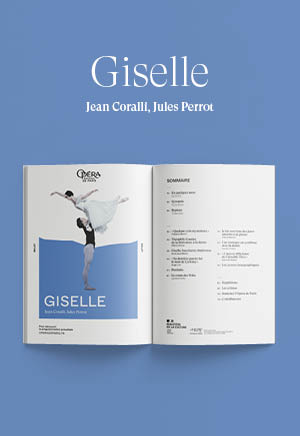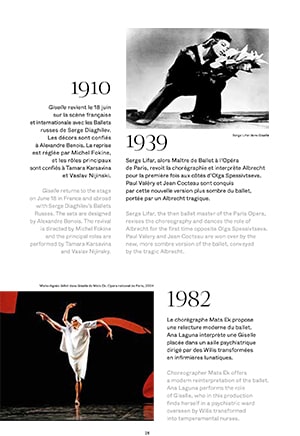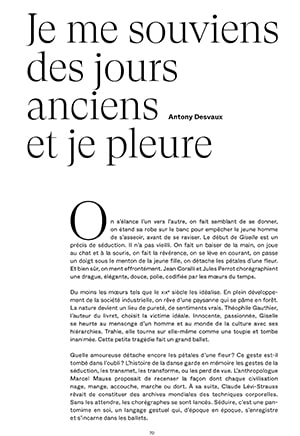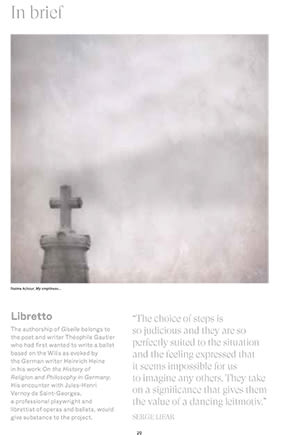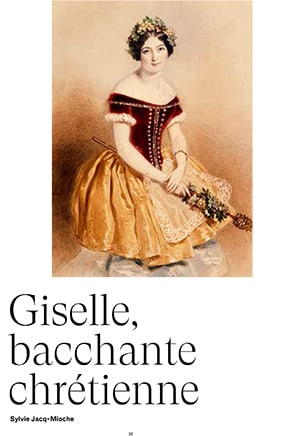Synopsis
Listen to the synopsis
Diaphanous tutus, pointe shoes, white gauze, tulle: Giselle marks the pinnacle of romanticism. In a bucolic landscape, a young girl dies of love and is transformed into a spirit that haunts the forest. Taken in by the Wilis, she enters an ethereal world where dance is the language of the soul. Her lover Albrecht, distraught, pursues this ghost at the risk of his life.
The ballerinas, with their aerial presence, defy him just as they do gravity. The mist-shrouded set reveals spectral visions enhanced by Adolphe Adam’s bewitching score.
Premiered at the Royal Academy of Music on 28 June 1841, the ballet travelled to Russia and disappeared from the repertoire before its return to France in 1910. Today, in Patrice Bart and Eugène Polyakov’s version, faithful to the original choreography by Jean Coralli and Jules Perrot, the ballet continues to offer us its magic.
Duration : 2h10 with 1 interval
-
Opening
-
First Part 55 min
-
Intermission 20 min
-
Second Part 55 min
-
End
Artists
Ballet in two acts (1841)
Creative team
Cast
- Monday 29 April 2024 at 19:30
- Thursday 02 May 2024 at 19:30
- Saturday 04 May 2024 at 19:30
- Sunday 05 May 2024 at 14:30
- Monday 06 May 2024 at 19:30
- Wednesday 08 May 2024 at 19:30
- Friday 10 May 2024 at 19:30
- Monday 13 May 2024 at 19:30
- Tuesday 14 May 2024 at 19:30
- Wednesday 15 May 2024 at 19:30
- Thursday 16 May 2024 at 19:30
- Friday 17 May 2024 at 19:30
- Saturday 18 May 2024 at 19:30
- Tuesday 21 May 2024 at 19:30
- Wednesday 22 May 2024 at 19:30
- Thursday 23 May 2024 at 19:30
- Friday 24 May 2024 at 19:30
- Saturday 25 May 2024 at 19:30
- Monday 27 May 2024 at 19:30
- Tuesday 28 May 2024 at 19:30
- Wednesday 29 May 2024 at 19:30
- Thursday 30 May 2024 at 19:30
- Friday 31 May 2024 at 19:30
- Saturday 01 June 2024 at 19:30
Latest update 07 September 2022, cast is likely to change.
Latest update 07 September 2022, cast is likely to change.
Latest update 07 September 2022, cast is likely to change.
Latest update 07 September 2022, cast is likely to change.
Latest update 07 September 2022, cast is likely to change.
Latest update 07 September 2022, cast is likely to change.
Latest update 07 September 2022, cast is likely to change.
Latest update 07 September 2022, cast is likely to change.
Latest update 07 September 2022, cast is likely to change.
Latest update 07 September 2022, cast is likely to change.
Latest update 07 September 2022, cast is likely to change.
Latest update 07 September 2022, cast is likely to change.
Latest update 07 September 2022, cast is likely to change.
Latest update 07 September 2022, cast is likely to change.
Latest update 07 September 2022, cast is likely to change.
Latest update 07 September 2022, cast is likely to change.
Latest update 07 September 2022, cast is likely to change.
Latest update 07 September 2022, cast is likely to change.
Latest update 07 September 2022, cast is likely to change.
Latest update 07 September 2022, cast is likely to change.
Latest update 07 September 2022, cast is likely to change.
Latest update 07 September 2022, cast is likely to change.
Latest update 07 September 2022, cast is likely to change.
Latest update 07 September 2022, cast is likely to change.
The Étoiles, the Premières Danseuses, the Premiers Danseurs and the Paris Opera Corps de Ballet
Marianela Núñez, Principal dancer with the Royal Ballet, will be performing the role of Giselle on May 25th and 27th, 2024.
The Paris Opera Orchestra
Media


Watch online the recording from season 19/20 on Paris Opera Play, with Dorothée Gilbert, Mathieu Ganio, Valentine Colasante...
Access and services
Palais Garnier
Place de l'Opéra
75009 Paris
Public transport
Underground Opéra (lignes 3, 7 et 8), Chaussée d’Antin (lignes 7 et 9), Madeleine (lignes 8 et 14), Auber (RER A)
Bus 20, 21, 27, 29, 32, 45, 52, 66, 68, 95, N15, N16
Calculate my routeCar park
Parking Q-Park Edouard VII and Q-Park Meyerbeer 16 rue Bruno Coquatrix 4 rue de la Chaussée d'Antin 75009 Paris
Book your spot at a reduced price-
Cloakrooms
Free cloakrooms are at your disposal. The comprehensive list of prohibited items is available here.
-
Bars
Reservation of drinks and light refreshments for the intervals is possible online up to 24 hours prior to your visit, or at the bars before each performance.
-
Restaurant
CoCo is open every day from 12:00 pm to 2:00 am. More information on coco-paris.com or at +33 1 42 68 86 80 (reservations).
-
Parking
Parking is available at two nearby locations: Q-Park Edouard VII located at 16 rue Bruno Coquatrix - 75009 Paris and Q-Park Meyerbeer located at 4 rue de la Chaussée d'Antin - 75009 Paris
At the Palais Garnier, buy €10 tickets for seats in the 6th category (very limited visibility, two tickets maximum per person) on the day of the performance at the Box offices.
In both our venues, discounted tickets are sold at the box offices from 30 minutes before the show:
- €25 tickets for under-28s, unemployed people (with documentary proof less than 3 months old) and senior citizens over 65 with non-taxable income (proof of tax exemption for the current year required)
- €40 tickets for senior citizens over 65
Get samples of the operas and ballets at the Paris Opera gift shops: programmes, books, recordings, and also stationery, jewellery, shirts, homeware and honey from Paris Opera.
Palais Garnier
- Every day from 10 a.m. to 6:30 p.m. and until performances end
- Get in from Place de l’Opéra or from within the theatre’s public areas
- For more information: +33 1 53 43 03 97
Online
Palais Garnier
Place de l'Opéra
75009 Paris
Public transport
Underground Opéra (lignes 3, 7 et 8), Chaussée d’Antin (lignes 7 et 9), Madeleine (lignes 8 et 14), Auber (RER A)
Bus 20, 21, 27, 29, 32, 45, 52, 66, 68, 95, N15, N16
Calculate my routeCar park
Parking Q-Park Edouard VII and Q-Park Meyerbeer 16 rue Bruno Coquatrix 4 rue de la Chaussée d'Antin 75009 Paris
Book your spot at a reduced price-
Cloakrooms
Free cloakrooms are at your disposal. The comprehensive list of prohibited items is available here.
-
Bars
Reservation of drinks and light refreshments for the intervals is possible online up to 24 hours prior to your visit, or at the bars before each performance.
-
Restaurant
CoCo is open every day from 12:00 pm to 2:00 am. More information on coco-paris.com or at +33 1 42 68 86 80 (reservations).
-
Parking
Parking is available at two nearby locations: Q-Park Edouard VII located at 16 rue Bruno Coquatrix - 75009 Paris and Q-Park Meyerbeer located at 4 rue de la Chaussée d'Antin - 75009 Paris
At the Palais Garnier, buy €10 tickets for seats in the 6th category (very limited visibility, two tickets maximum per person) on the day of the performance at the Box offices.
In both our venues, discounted tickets are sold at the box offices from 30 minutes before the show:
- €25 tickets for under-28s, unemployed people (with documentary proof less than 3 months old) and senior citizens over 65 with non-taxable income (proof of tax exemption for the current year required)
- €40 tickets for senior citizens over 65
Get samples of the operas and ballets at the Paris Opera gift shops: programmes, books, recordings, and also stationery, jewellery, shirts, homeware and honey from Paris Opera.
Palais Garnier
- Every day from 10 a.m. to 6:30 p.m. and until performances end
- Get in from Place de l’Opéra or from within the theatre’s public areas
- For more information: +33 1 53 43 03 97
Online

Discover opera and ballet in another way

Dive into the Opera world and get insights on opera and pop culture or ballet and cinema. Scan this code to access all the quiz and blindtests on your mobile.
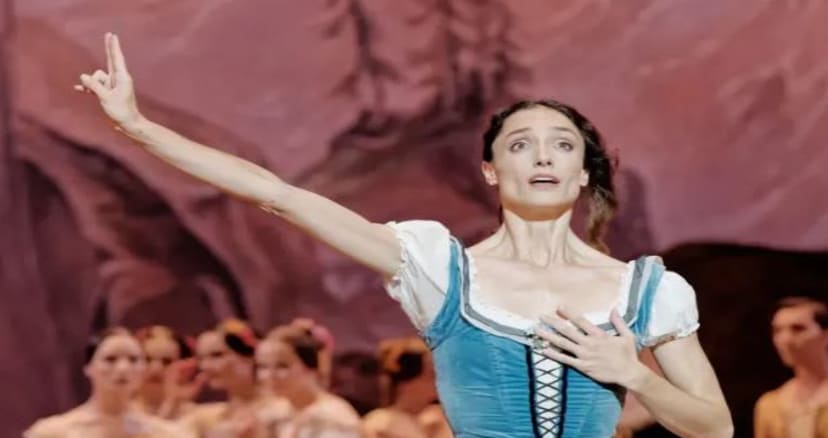
3 min
Giselle
Giselle Quiz - Loves me, loves me not
When Giselle discovers that the dashing young man she loves is already betrothed to Princess Bathilde, she goes mad. Bathilde… Maybe one of Batman’s relatives? Anyway, the last scene of the first act ends with the death of Giselle. Follow me, I’ll explain it to you, step by step.
DiscoverYou will also like























































































